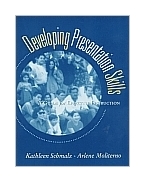|
||
• wydawnictwa polskie
• Zamów informacje o nowościach z wybranego tematu • kontakt
• Cookies na stronie |
DEVELOPING PRESENTATION SKILLS. A GUIDE FOR EFFECTIVE INSTRUCTION.SCHMALZ K, MOLITERNO A.wydawnictwo: ALLYN AND BACON , rok wydania 2001, wydanie Icena netto: Experienced educators understand the very complex nature of student learning. Brooks and Brooks (1999) observed that teachers develop classroom practices and negotiate curriculum in an effort to enhance student learning, but it is virtually impossible to control what students learn. Even when teachers structure lessons and curriculum to promote learning for all students, each student still constructs his/her own unique meaning to the lesson. Teachers have some control over what they plan to teach, but have far less control over what students learn. Constuctivist learning theory suggests that learners are active participants who pursue areas of knowledge based on their interests and a need to know. Given the nature of the learner, the teacher is viewed as a facilitator who structures the learning environment so that the student can actively construct knowledge. Grennon, Brooks and Brooks (1993) identify five central tenets of constructivism that are useful in understanding productive teacher behavior in the classroom. The five tenets are: Constructivist teachers seek to understand their students. Constructivist teachers plan lessons to challenge students' understanding so that new knowledge is constructed. Constructivist teachers understand that the curriculum must be relevant to students. Constructivist teachers plan instruction holistically and relate details to the larger picture. Constructivist teachers assess student learning in the context of daily classroom experiences. Developing Presentation Skills: A Guide for Effective Instruction offers a Constructivist approach to instruction with an emphasis on the process that occurs within the classroom setting. Within the framework of the Instructional Plan Format, Part I of this text directs teachers to take on the important tasks of planning instruction, presenting lessons and assessing learning. It also prompts teachers to better understand learners, challenge students' understanding, and make learning relevant. Part II of this text is a collection of essays written by educational professionals from different academic disciplines. These essays are designed to provide the reader with a variety of pedagogical tools and assignment ideas for instructional presentations. The essays enhance the readers understanding and demonstrate the practical application of strategies for instruction and presentation. Dr. Edward A. Schmalz discusses the issue of speech anxiety. Since teachers are often called upon to speak before a wide variety of audiences, speech anxiety can be a concern. He offers the classroom teacher some practical strategies to cope with this problem. Dr. Margaret Egan, S.C. describes how to use graphic organizers to enhance teaching and support student learning in the college classroom. Although her focus is on the adult learner, the graphic organizer is a simple tool that teachers at all grade levels will want to use regularly within their instructional presentations. Dr. Kathleen Schmalz discusses the importance of active learning within the classroom setting. She describes how writing assignments can be used effectively to engage students and enhance learning within specific disciplines and subject areas. Dr. Barbara Smith's section also addresses the issue of student writing. Seeing the classroom as a community of learners, she provides some practical approaches to motivating reluctant student writers. Additionally, she describes thesis-based writing processes and assignments for interdisciplinary use. She presents writing as a tool for better understanding of course content, and holds that writing and thinking (both messy processes) are happily connected: writing clarifies thinking and clearer thought yields improved writing. In consideration of student writing, Stephen Feyl addresses the issue of student research writing and reports. Feyl, a librarian, shares his expertise and experience in helping students approach library research assignments. He offers practical suggestions for structuring students' assignments and facilitating the research process. Classroom teachers will find his descriptions of how to use electronic databases and resources especially useful. In an era when schools are expected to address more than academic subjects, the curriculum increasingly includes values' education, ethics and character education. To this end, Dr. Kathleen Schmalz writes about teaching as an ethical profession. In her essay, she describes professional ethics for classroom teachers and addresses teaching ethics to students. Dr. Edward Zukowski's essay further elaborates on these issues by describing how teachers can foster ethical thought within the classroom setting. He describes some general strategies and specific techniques that can be used by teachers to engage students in discussion of moral and ethical concerns. According to Robin Fogarty (1999), effective learning within the classroom occurs naturally and with purpose. Such learning is characterized by the creativity of the teacher who must "design learning that empowers the learner to make meaning through the mindful manipulation of input." We believe that Developing Presentation Skills: A Guide for Effective Instruction is a text that can assist teachers in designing creative, interactive and student-centered learning experiences within the classroom. 209 pages Księgarnia nie działa. Nie odpowiadamy na pytania i nie realizujemy zamówien. Do odwolania !. |


